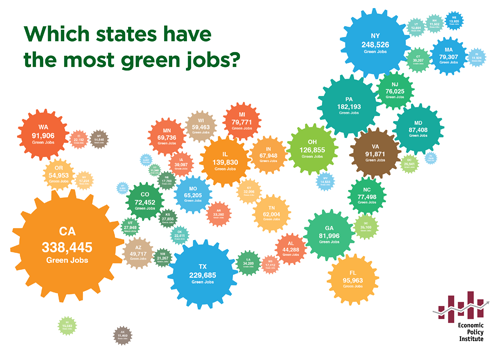 By Ethan Pollack | October 10, 2012
By Ethan Pollack | October 10, 2012
Economic Policy Institute
What is a green job? We tend to think of a green job as one that benefits the environment, but illustrations tend to be limited to fossil fuels vs. renewable energy. In fact, whether to categorize a specific occupation as a green job is not always straightforward: what about bus drivers, or software engineers who help design smart-grid technologies, or commercial construction workers? The economy is made up of more than coal miners and solar panel installers, and many occupations have significant roles to play along the spectrum between the fossil fuel economy and a “clean” economy. Without a definition of what green jobs are it is difficult to count them, much less determine what role green jobs and industries play in the economy today and going forward.
3.1 million American green jobs: The full picture Which states have the most green jobs? Which industries have the most green jobs? The public sector is greener than the private sector 10 states with the greenest workforce10 states with the most room for green jobs growth. The states with the most and least green jobs per capita
The Brookings Institution and the Pew Center on the States have both attempted to answer these questions, releasing reports that categorize green jobs on a detailed industry and occupational level. And in March 2012, the Bureau of Labor Statistics (BLS) weighed in on this debate with a detailed survey of the green economy that defines green jobs, identifies the establishments producing green goods and services, and estimates the number of jobs involved (BLS 2012c). Surprisingly, this survey has received little attention aside from the occasional partisan attack. But the data itself are fascinating, providing a starting point for evaluating the green economy. Moreover, matching these data with existing BLS data on employment trends yields several intriguing findings:
Greener industries grow faster than the overall economy. For every percentage-point increase in an industry’s green intensity (the share of employment in green jobs), annual employment growth was 0.034 percentage points higher. Projections for the next 10 years suggest continued jobs benefits from green intensity.
States with greater green intensity have generally fared better in the current economic downturn.
Green jobs are accessible to workers without a college degree. For every one percentage-point increase in green intensity in a given industry, there was a corresponding 0.28 percentage-point increase in the share of jobs in that industry held by workers without a four-year college degree.
Manufacturing plays a strong role in the green economy. Although it represents only 10.8 percent of total private employment, manufacturing accounts for 20.4 percent of green jobs.
Green jobs go beyond the renewable energy industry. For example, nearly 50 percent of jobs in the water industry are green jobs, and the sector has opportunity to grow not just overall but in green intensity.
These findings suggest that investments in the green economy could accomplish multiple goals beyond simply creating a more sustainable economy. First, the strong economic performance of green industries suggests that green investments could play an important role in a broader short- and long-term job creation strategy. Second, investments in green jobs could promote economic mobility by opening up the labor market to more workers without a college degree. And finally, the investment opportunities for going green are vast throughout nearly all industries.











